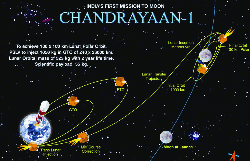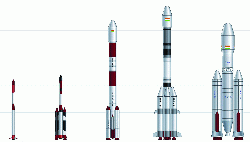Archives
India's First Mission to Moon- Chandrayaan-I
This is India’s first moon mission and plays a vital role in the spurt of space missions in Asia. The first Asian nation to launch a space exploration vehicle was Japan which launched its Kaguya space craft in October 2007. A month later, China’s Chang’e – 1 entered lunar orbit. China also became the first Asian country to put its own astronauts into space when it did so in 2008. It followed that feat in September 2008 with the first ever space walk. Now, India has joined the likes of USA, Russia, the European Space Agency, Japan and China in the elite club of nations that have sent missions to the moon.

The name of India’s space craft – Chandrayaan is derived from two ancient Sanskrit words; namely Chandra which means moon and yaan which means vehicle. It is India’s first planetary science and exploration mission.
Chandrayaan I which was launched from Satish Dhawan Space Centre at Sriharikota will take about five days to complete its journey and enter lunar orbit. Once there, it will begin its mission of exploration, stressing on the preparation of a three dimensional atlas (with high spatial and altitude resolution of 5 – 10 m) on both the near and far sides of the moon. It will also conduct chemical and mineralogical mapping of the entire lunar surface for the distribution of elements. This will all be done while Chandrayaan orbits the moon as at no given time during this particular mission will it actually land on the moon. The closest that it will actually come to the moon is a distance of 100 kms.
At a cost of aproxamitely 386 crore, which includes Rs. 53 crore for Payload Development, Rs. 83 crore for Spacecraft Bus, Rs. 100 crore towards establishment of Deep Space Network, Rs. 100 crore for PSLV Launch Vehicle and Rs. 50 crore for Scientific Data Centre, Central network Support and Programme Management expenses, no expenditure has been spared to ensure the success of this mission and remedial measures in case of any emergency. If a component of the spacecraft fails, controllers on Earth can instruct Chandrayaan to bring a backup online. If the spacecraft points in the wrong direction, its altitude can be corrected. If the spacecraft deviates from the desired trajectory, a controlled burn (thruster firing) can be performed to put it back on track.
This particular mission will last two years and officials say that by re – mapping the lunar surface, it will lay the groundwork for future voyages. The technology involved in getting to the moon has not changed much since the 1960s when the US and Russia first made it to the moon. Scott Pace who is a former associate administrator at NASA and is now the director of space policy at the George Washington University said that the best maps of the moon available today were made about four decades ago during the Apollo era. “We don’t really have really good maps of the moon with modern instruments. The quality of the Martian maps, I would make a general argument, is superior to what we have of the moon,” Pace said.

Indian Space Research Organisation (ISRO) Chairman G Madhavan Nair said that this is a historic moment as far as India is concerned. “We have started our journey to the moon and the first leg of the journey has gone perfectly well,” he said.
With the success of this launch, the Indian Space Research Orgnisation (ISRO) is now gearing up for the complex and challenging task of the proposed manned mission to the moon by 2015. Mr. Nair said that the successful launch of Chandrayaan has given them some breathing room. “We are looking at how we can design a capsule which can carry two astronauts on board a GSLV rocket,” he said.

